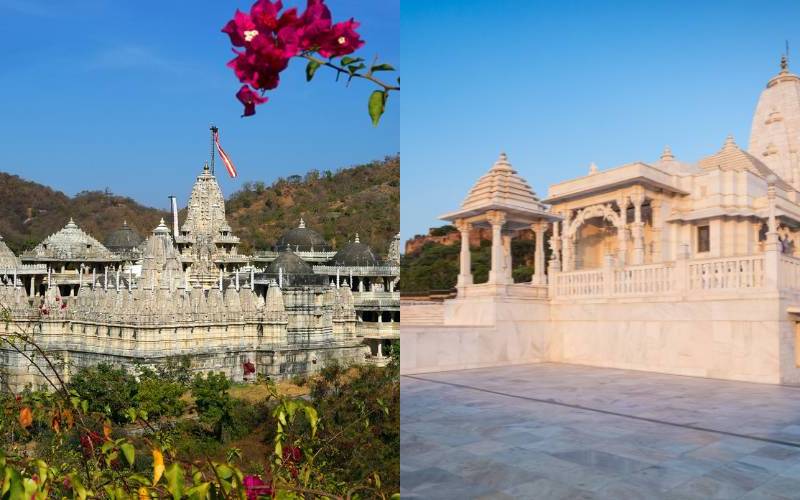Are you a spiritual seeker or curious wanderer eager for an exciting journey? If so, then Rajasthan should be your next destination! With its incredible architecture and rich history, this vibrant state in India offers travelers a vast array of sacred temples to explore. Journey with us as we uncover the 14 most famous temples in Rajasthan – a unique blend of past tradition and modern craftsmanship that will surely leave a lasting impression. Ready to begin your epic spiritual journey? Let’s go!
Table of Contents
Here are the top 14 List of the Most Famous Temples in Rajasthan
1. Khatu Shyam Ji Temple
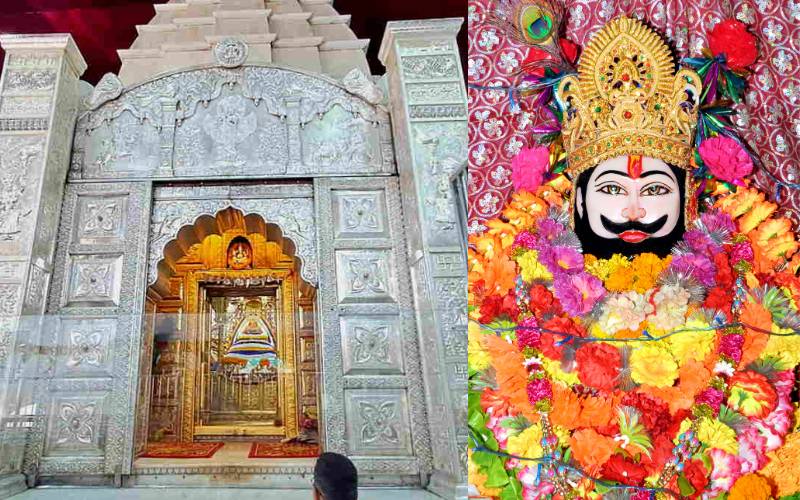
Khatu Shyam Ji Temple is one of the most visited temples in Rajasthan. It is located near the village of Khatu, in Sikar district. The temple is devoted to Lord Krishna and it is believed that he had visited this place once during a military campaign.
The temple gets its name from the legendary god, Shree Shyamji Bhagwan or Lord Krishna who emerged from an old banyan tree when worshipped by Sudama (Lord Krishna’s friend). Hindu followers place considerable value on this ancient temple, which receives a lot of devotees each year.
Every year on Phalguna Purnima, thousands of devotees come here to take part in a mela (fair) and seek the blessings of Lord Krishna.
2. Ranakpur Jain Temple
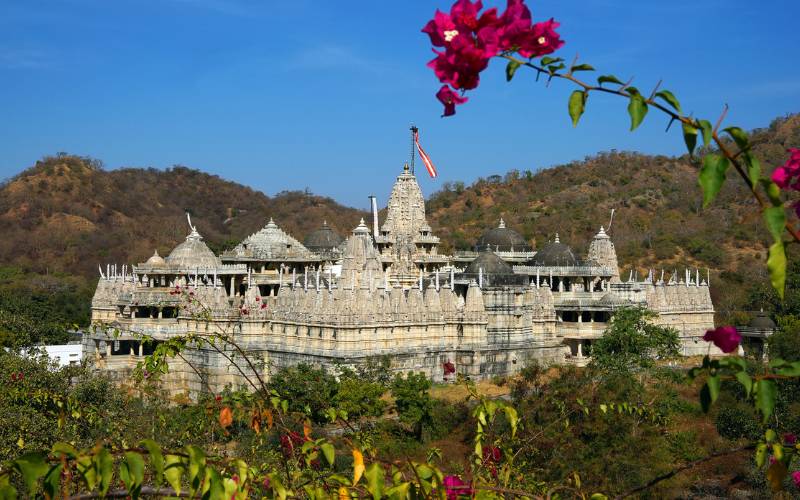
The next temple on the list is Ranakpur Jain Temple, situated in the Pali district of Rajasthan. It is one of the five most important pilgrimage sites for Jains and is dedicated to Adinath, the first Tirthankara (saviour).
Built-in the 15th century AD, Ranakpur Temple stands out due to its elaborate carving and architecture. The amazing structure consists of over 1444 pillars depicting intricate designs all around.
Also Read:- Best places to visit in Rajasthan
3. Eklingji Temple
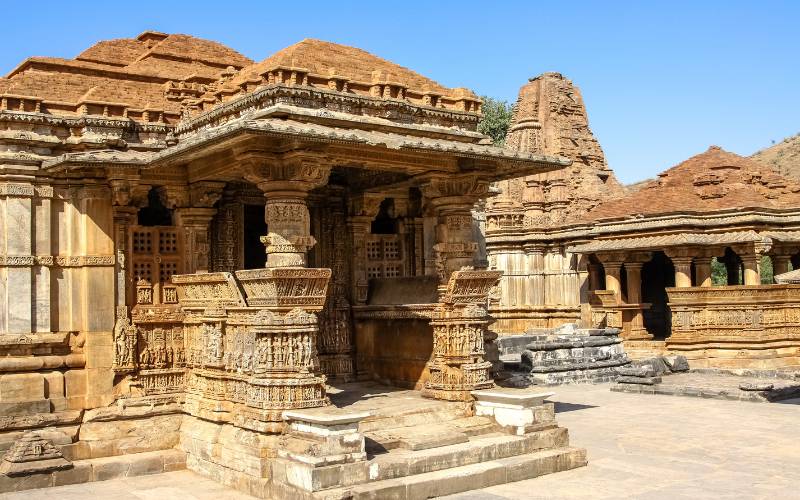
Eklingji Temple is an ancient temple dedicated to Lord Shiva located near Udaipur in Rajasthan. The temple originates from the 8th century. It’s a highly important religious destination for Hindus in India. The temple complex consists of 108 temples and has been constructed with white marble, giving it a beautiful look.
Devotees from all parts of India visit this temple to seek blessings from Eklingji, who is known as the ruler of Mewar (the region covering Udaipur). The walls feature complex carvings and artworks. These depict a range of Hindu deities, including:- Vishnu, Lakshmi, Ganesha, Kartikeya and others. Every day hundreds of devotees queue up here to get a glimpse of the deity.
4. Brahma Temple
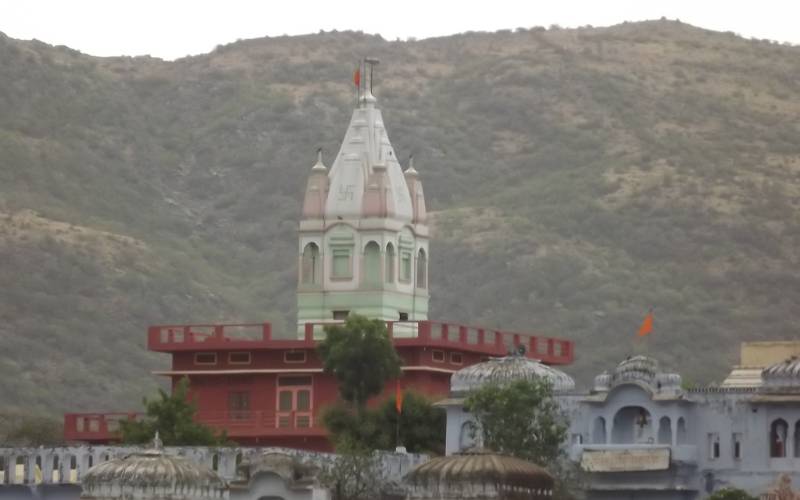
In Pushkar, Rajasthan, there is a well-known Hindu temple called the Brahma Temple. One of the few temples that are specifically dedicated to Lord Brahma, the Hindu religion’s Creator God. The present structure has four spires which are crowned with gold-plated kalash (brass pots) on top.
Inside the temple, there is an idol of Lord Brahma – his four heads symbolize creation, preservation, destruction and eternity. People from all over India come here to seek blessings from Lord Brahma for a better life ahead. There are additional temples for other gods and goddesses:- Laxmi, Saraswati, Ganesh, Shiva, and Parvati.
5. Mehandipur Balaji Temple
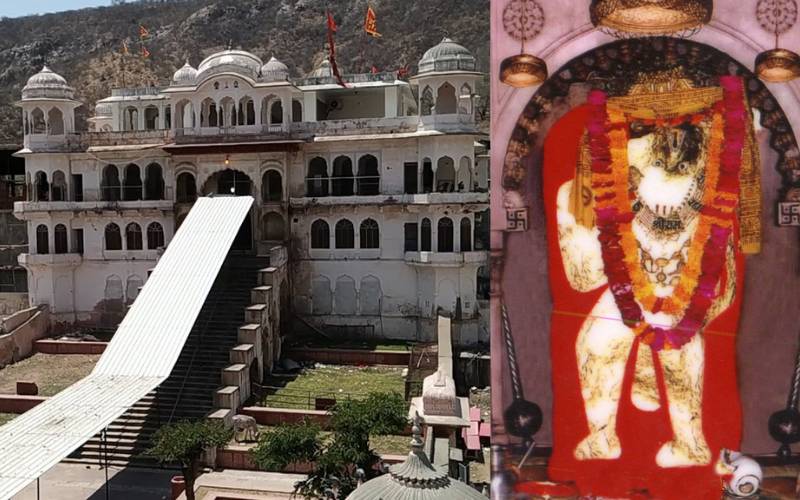
Mehandipur Balaji Temple is located in the Dausa district of Rajasthan. This temple has been known for its ritualistic exorcism of spirits since ancient times, and many devotees believe that their prayers to Lord Hanuman here are answered more quickly than anywhere else.
The temple, situated on a hill, demands that visitors ascend a multitude of steps to reach the shrine of Lord Hanuman at the top. As you step in, the breathtaking splendor of golden idols on the walls, intricate marble statues on the floor, and a big white dome make this temple a truly remarkable sight.
Also Read:- Famous Food of Rajasthan
6. Birla Mandir
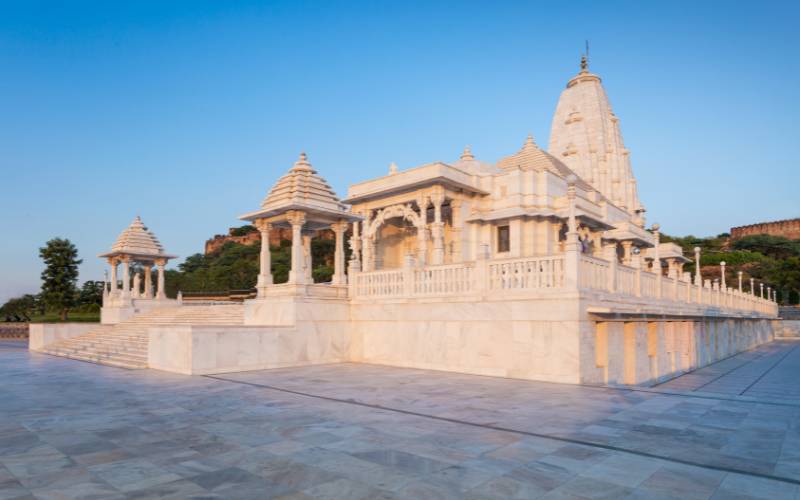
The Birla Mandir stands majestically at the base of Moti Dungari Hill in Jaipur, Rajasthan. In comparison to other temples in Rajasthan, this Hindu temple is fairly contemporary and was constructed primarily out of white marble. It’s grand structure and intricate architectural details make it a sight to behold for any visitor.
It is believed that this temple was constructed by the industrialist and philanthropist Shri G.D. Birla of the famous Birla family. The shrine of Lord Vishnu dominates the interior space while there are several shrines dedicated to other important gods like Shiva, Krishna, Rama and more located within its premises.
The walls feature gold-plated idols of various deities and some of the idols are even made from pure gold.
7. Karni Mata Temple
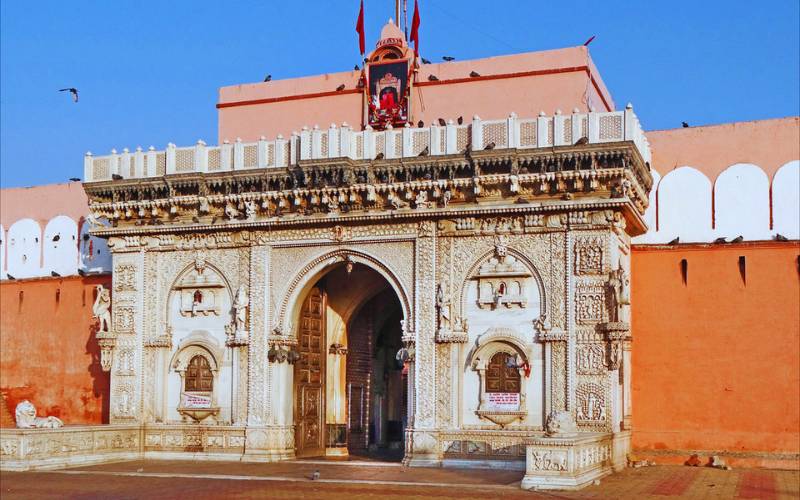
Karni Mata Temple, located in the city of Bikaner in Rajasthan, is a unique temple that stands out from the rest with its thousands of rats. The temple is dedicated to Karni Mata, who is believed to be an incarnation of the Hindu goddess Durga and was built by Maharaja Ganga Singh in 1917. The temple is a key site for Hindus in Northern India and draws in visitors worldwide for both its religious importance and reputation.
The main shrine inside the temple houses an idol of Karni Mata along with several other idols representing deities such as Lord Shiva, Lord Krishna, and Lord Rama. The entire premises are filled with silver and gold-plated statues of rats, which are believed to represent Karni Mata’s descendants and devotees.
The temple also has a unique custom in which, if a pilgrim drops a silver or gold rat into one of the temple’s many pools, it is believed that Karni Mata will grant them a wish.
8. Jagdish Temple
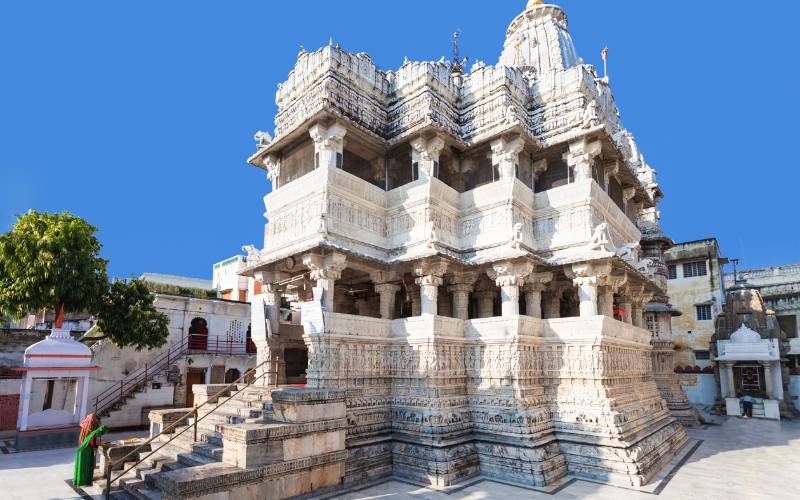
The Jagdish Temple, standing as one of Udaipur’s major temples, perfectly exemplifies Indo-Aryan architectural mastery. It was built by Maharana Jagat Singh I in 1651 AD who dedicated this temple to Lord Vishnu, the presiding deity of the city.
The main structure is an impressive double-storeyed edifice with a mandapa (prayer hall) and porch on either side, topped by a shikara (tower). Inside the temple are several other shrines which include those for Laxmi Narayan, Ganesh, Shiva and Shakti.
The outer walls of this temple are decorated with intricately carved sculptures depicting various themes from Hindu mythology such as Ravana shaking Kailash, Mahabharata and Krishna Lila. Two huge stone elephants that flank the temple’s entrance are thought to have the strength to ward off evil spirits.
A well-known temple in Rajasthan. It draws a lot of devotees, especially during religious celebrations like Janmashtami.
9. Jagat Shiromani Temple
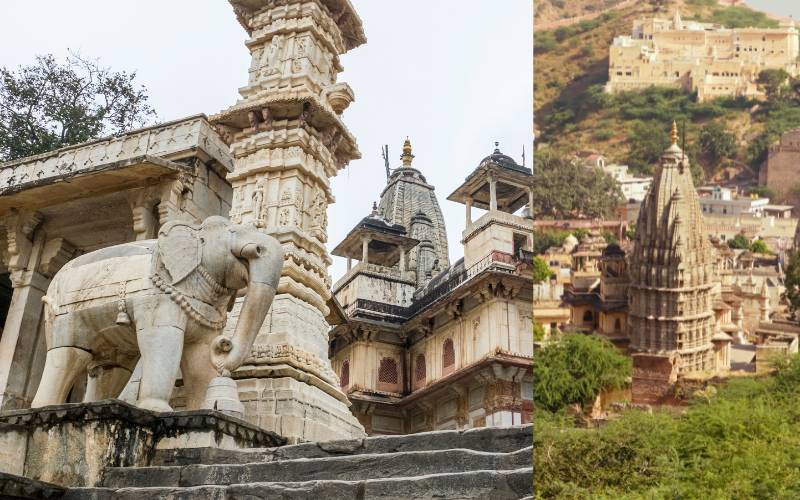
The Jagat Shiromani Temple is renowned for its stunning architecture and intricate carvings that adorn the walls. The temple is built on a 22-feet tall base and has a pyramid-shaped peak with four points at the top. It houses two large idols of Meera Bai in the centre, flanked by Krishna and Vishnu on either side.
The sanctum sanctorum of the temple is made from marble with an iconic shikhara tower standing at its peak. Along with ornately carved sculptures of various Hindu gods and goddesses. Scenes from the Ramayana and Mahabharata epics are also shown inside the building.
The temple complex also contains a number of other shrines, including those of Mahavir Swami and Shiva’s numerous incarnations(avatars). The temple also has a kund or holy tank on its premises which is believed to have medicinal properties. It’s a popular pilgrimage site that attracts thousands of devotees every year during the festive season of Janmashtami.
10. Rani Sati Temple
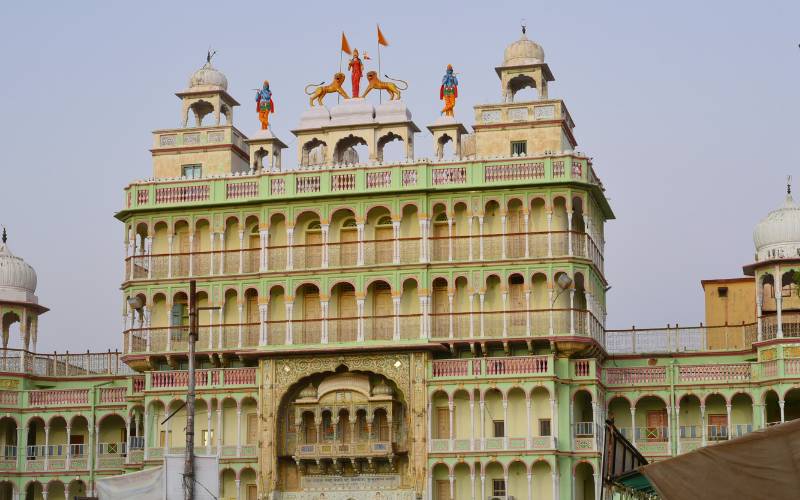
The Rani Sati Temple is one of the most well-known temples in Jhunjhunu. Every year, it draws millions of tourists and followers. The temple was constructed in commemoration of Rani Sati Dadi, a brave queen who sacrificed her life on the pyre of her deceased husband according to the ancient Hindu practice called Jauhar.
Many pilgrims visit this place seeking blessings from Rani Sati Dadi as she is believed to be an incarnation of Goddess Parvati.
It has a unique architecture that consists of numerous temples within its premises dedicated to different gods and goddesses like Lord Shiva, Goddess Parvati, Hanumanji and Ganesha. A huge idol of Rani Sati Dadi can also be found at the temple. Devotees offer various flowers, fruits and other offerings to please the deity.
Also Read:- Best Places for Destination Wedding in Rajasthan
11. Shrinathji Temple
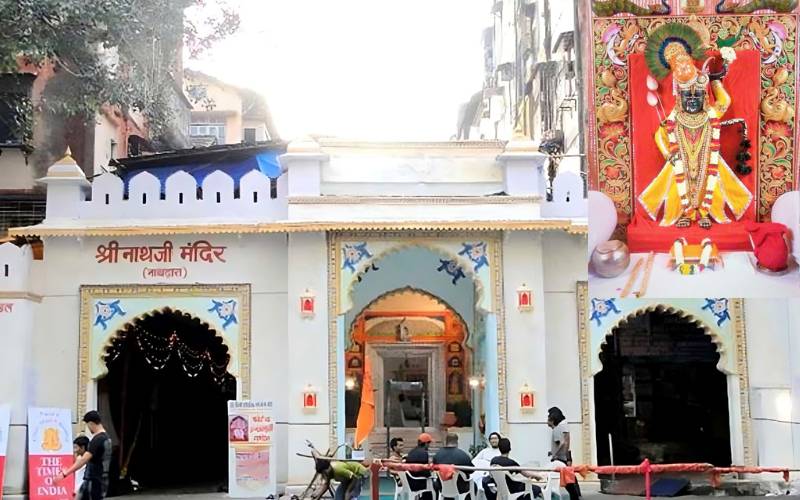
The Shrinathji Temple in Nathdwara is one of the most famous temples in Rajasthan. It is an important pilgrimage site for followers of Pushti Marg or Vallabh Sampradaya, a Hindu sect. This temple belongs to Shrinathji – a seven-year-old Krishna incarnation. It is situated beside the Banas River. This idol was initially situated at Matura and moved to Nathdwara by Meherban Akbar Khan and his son Fateh Khan in 1671 AD.
The temple has been home to many rituals since then including ‘Aarti’, or worship through singing devotional songs. Devotees offer various flowers, fruits and other offerings to please the lord.
12. Salasar Balaji Temple
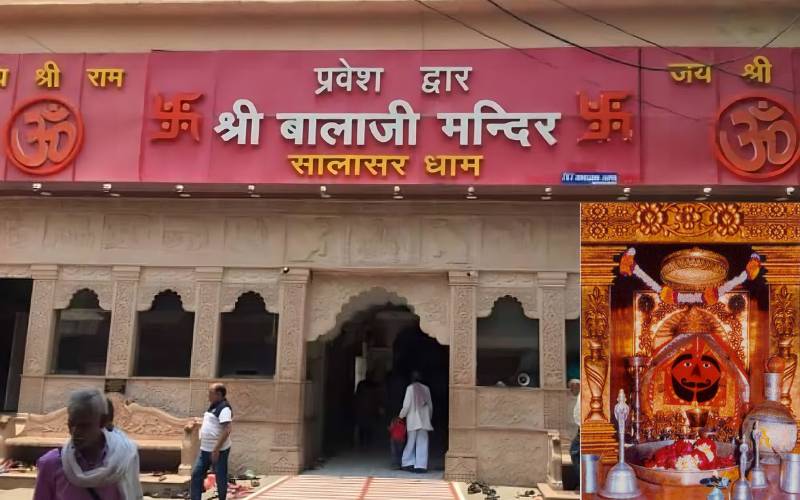
One of the most renowned temples in Rajasthan is Salasar Balaji Temple, which is located in the Churu area. It is dedicated to Lord Hanuman who is also known as Balaji among devotees all over India. The temple was constructed in 1752 by Maharaja Sapat Singh of Bikaner.
It has been a pilgrim center for people from all across India since then. Devotees usually offer flowers, fruits, sweets and other offerings to please Lord Hanuman while singing his ‘aarti’ or devotional songs. The idol of Lord Hanuman at Salasar Balaji Temple is huge and stands tall with its arms spread outwards symbolizing protection and guidance.
There are two separate shrines of Lord Shiva and Goddess Durga in the main temple complex.
13. Sundha Mata Temple
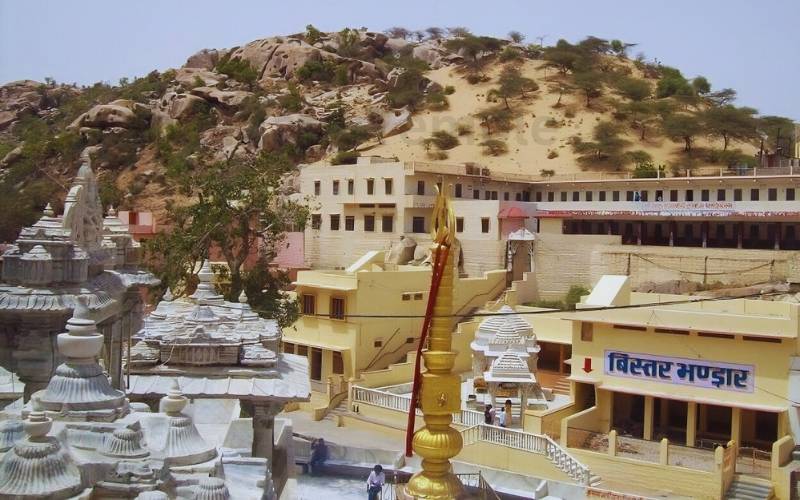
Sundha Mata Temple is a popular pilgrimage destination in Rajasthan located at the base of Mount Abu. This temple honors Sunanda Devi, who was thought to be an incarnation of Goddess Parvati and Lord Shiva’s wife. The main deity inside the temple is a black stone idol of Sundha Mata that stands 8 feet tall.
Devotees from far and wide visit this temple to seek blessings for their families, career growth and overall prosperity. According to Hindu folklore, it is said that worshipping here can also get rid of any problems related to black magic or ill health. Furthermore, tourists visiting Mount Abu should not miss out on this spiritual experience as it gives them a chance to connect with the gods and devotees alike.
14. Jeen Mata Temple
Jeen Mata Temple is a sacred temple dedicated to the Hindu goddess Jeen Mata in Rajasthan, India. This temple rises magnificently at the base of the Aravalli hills and is one of the most renowned in Rajasthan. According to Hindu mythology, Jeen Mata symbolizes fertility and she is worshipped by women who are seeking blessings for childbirth or conception.
The main deity inside this temple is a silver idol of Jeen Mata that stands 10 feet tall. The walls of this temple are adorned with beautiful carvings that depict Lord Shiva and deities from other mythological stories. Devotees come here from all over India to offer their prayers and receive blessings from Jeen Mata. Furthermore, tourists visiting Rajasthan often make sure to pay a visit to this temple.
Importance of Temples in Rajasthan’s Culture
What makes these temples so special? They show how diverse and spiritual Rajasthan is. These temples attract visitors worldwide. They give an opportunity to discover the ancient traditions and ideologies that have sculpted the culture of Rajasthan for hundreds of years.
1. Unique Architecture: Each of the famous temples in Rajasthan has its own unique style. Examples include the detailed carvings in the Dilwara Jain Temples and the stunning design of the Eklingji Temple. These buildings are like artwork, each telling an ancient story through their designs and sculptures.
2. Preserving Traditional Arts: Temples in Rajasthan help to keep traditional art forms, like music and dance, alive. They host festivals and ceremonies where these arts can be enjoyed. This helps to make sure these traditions don’t get lost over time.
3. Community Building: Temples in Rajasthan do more than just preserve history and culture. They also bring people together. Many temples host events like community meals and charity work. These events create a sense of togetherness and remind people to help others.
4. Celebration of Culture: The famous temples in Rajasthan celebrate the area’s culture. They are a significant key to Rajasthan’s uniqueness. They give access to its past, celebrate its culture, and serve as gathering spots for its communities.
5. Memorable Spiritual Journey: Visiting these temples is more than just a sightseeing trip. It’s a spiritual journey. These temples serve as centers for celebrating Rajasthani culture, learning about its history, and feeling a sense of community.
Conclusion
To conclude, the 14 most famous temples in Rajasthan offer a unique spiritual journey that is both meaningful and memorable. They provide insight into the culture of Rajasthan, celebrate its history, and serve as gathering spots for its communities. These temples ought to be on your must-see list whether you’re seeking a place to relax and think or are looking to explore the area!
They offer an immersive experience that is unmatched by anything else because of its beautiful architecture and alluring environment. Anyone who visits these historic holy sites is guaranteed to come away with a strong impression. So come along and discover why these temples are some of India’s most iconic locations!
FAQs
Q. Are there specific dress codes in these temples?
Most temples in Rajasthan require modest attire. It’s best to cover shoulders and knees.
Q. How accessible are these temples for tourists?
These temples are accessible for tourists, with many located near major cities and tourist spots.
Q. What are some unique rituals practiced in these temples?
Rituals vary, from the rat-worship at Karni Mata Temple to the exorcism rituals at Mehandipur Balaji Temple.
Q. Are there any restrictions for non-Hindus or foreigners in these temples?
Generally, non-Hindus and foreigners are welcome, but some temple sanctums may be restricted.
Q. How can one contribute or participate in the temple’s activities or festivals?
Tourists can participate by attending festivals, donating, or volunteering during community events.

